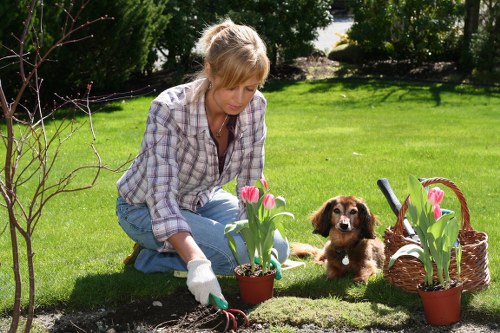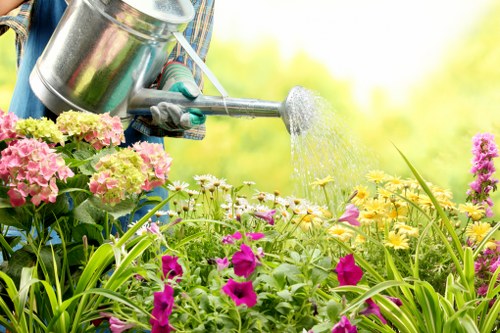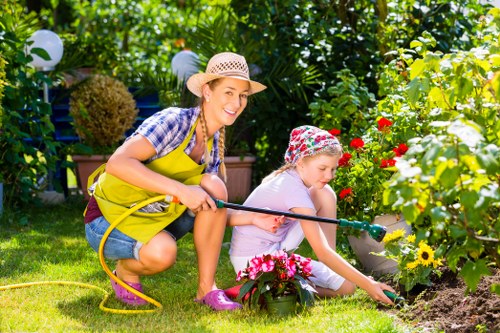Comprehensive Guide to Garden Fence Installation in Cleaners W1G
Introduction to Garden Fencing

Installing a garden fence is a significant enhancement to any property, offering both aesthetic appeal and functional benefits. In Cleaners W1G, where residential and commercial properties thrive, a well-installed garden fence can define space, provide security, and add value to your surroundings.
Whether you're looking to keep pets safe, create a private sanctuary, or simply improve the overall look of your garden, understanding the essentials of garden fence installation is crucial. This guide will walk you through everything you need to know about selecting, installing, and maintaining your garden fence in Cleaners W1G.
From choosing the right materials to complying with local regulations, we'll cover all the aspects to help you make an informed decision and ensure a seamless installation process.
Choosing the Right Fence Material

The first step in garden fence installation is selecting the appropriate material. The choice of material affects not only the appearance of your garden but also the durability and maintenance required.
In Cleaners W1G, popular fencing materials include:
- Wood: Offers a classic and natural look, easily customizable with paint or stain.
- Vinyl: Known for its low maintenance and longevity, vinyl fences come in various styles and colors.
- Metal: Includes options like aluminum and wrought iron, providing a sturdy and elegant barrier.
- Composite: A blend of wood fibers and plastic, offering durability with a wood-like appearance.
Each material has its advantages and considerations, so it's essential to evaluate your specific needs, budget, and the existing aesthetics of your property before making a decision.
Design Considerations for Your Garden Fence

Design is a critical element in garden fence installation. It should complement the architecture of your home and the landscape of your garden.
Key design aspects to consider include:
- Height and Scale: The fence height should align with your privacy needs and local regulations. Typically, residential fences range from 1.2 to 2 meters.
- Style: From traditional picket fences to modern horizontal slats, choose a style that matches your property's character.
- Color and Finish: Select colors that blend with your garden or make a statement. Finishes can protect the fence from weathering.
- Gate Placement: Determine where gates are needed for access and ease of use.
By carefully planning the design, you ensure that your garden fence not only serves its functional purpose but also enhances the overall beauty of your outdoor space.
Preparing for Installation

Proper preparation is essential for a successful garden fence installation in Cleaners W1G. This phase involves several steps:
- Assessing the Site: Evaluate the area where the fence will be installed, noting any slopes, existing vegetation, or obstacles.
- Obtaining Permits: Check with local authorities to determine if you need permits or if there are any restrictions on fence installation.
- Marking the Layout: Use stakes and strings to outline the fence line, ensuring it is straight and correctly positioned.
- Gathering Tools and Materials: Ensure you have all necessary tools, such as post hole diggers, levels, and measuring tapes, as well as the chosen fencing materials.
Thorough preparation helps prevent delays and ensures that the installation process proceeds smoothly.
Step-by-Step Installation Process

Installing a garden fence involves several key steps. Here's a detailed guide to help you through the process:
1. Setting the Posts
Begin by digging post holes at regular intervals, typically every 2 to 3 meters. Ensure the holes are deep enough to provide stability, usually about one-third of the post length. Place the posts in the holes, use a level to ensure they are vertical, and fill the holes with concrete for added support.
2. Attaching the Panels
Once the posts are set, attach the fence panels or rails horizontally or vertically, depending on your chosen design. Secure them firmly using appropriate fasteners, ensuring the panels are level and evenly spaced.
3. Installing the Gate
If your fence design includes a gate, install it by attaching hinges to the gate and the corresponding post. Ensure the gate swings freely and latches securely.
4. Finishing Touches
After the main structure is in place, apply any desired finishes, such as paint or stain, to protect the fence from the elements and enhance its appearance.
Maintenance Tips
Regular maintenance ensures the longevity of your garden fence. Here are some tips:
- Inspect the fence periodically for any signs of wear or damage.
- Reapply protective finishes as needed to prevent weathering.
- Repair any loose or broken panels promptly to maintain structural integrity.
- Keep the fence clean by removing debris and ensuring proper drainage.
By following these steps and maintaining your fence, you can enjoy a beautiful and functional garden barrier for years to come.
Compliance with Local Regulations

Before proceeding with your garden fence installation in Cleaners W1G, it's essential to be aware of and comply with local regulations. These rules are in place to ensure safety, aesthetics, and harmony within the community.
Key considerations include:
- Permits: Determine if a permit is required for your fence project.
- Height Restrictions: Adhere to any height limits set by local authorities.
- Material Restrictions: Some areas may prohibit certain materials to maintain neighborhood aesthetics.
- Boundary Lines: Ensure your fence is placed correctly to avoid encroaching on neighboring properties.
Consulting with local authorities or a professional installer can help navigate these regulations and ensure your installation complies with all necessary guidelines.
Cost Factors in Fence Installation
Understanding the cost factors involved in garden fence installation can help you budget effectively. Several elements influence the overall expense:
- Material Choice: Premium materials like wrought iron are more expensive than wood or vinyl.
- Size of the Area: Larger gardens require more materials and labor, increasing costs.
- Labor Costs: Professional installation fees vary based on complexity and regional rates.
- Design Complexity: Intricate designs with decorative elements may require additional time and resources.
- Permitting Fees: If permits are required, this will add to the total cost.
By evaluating these factors, you can make informed decisions that balance quality and affordability for your garden fence project.
Benefits of Professional Installation
While DIY fence installation can save money upfront, opting for professional installation in Cleaners W1G offers several advantages:
- Expertise: Professionals have the knowledge and experience to handle various materials and designs effectively.
- Time Efficiency: Professional installers can complete the project more quickly, minimizing disruption.
- Quality Assurance: Ensures the fence is constructed correctly, providing longevity and structural integrity.
- Compliance: Professionals are familiar with local regulations and can ensure your fence complies with all guidelines.
- Warranty: Many professionals offer warranties on their work, providing peace of mind.
Investing in professional installation can lead to a higher quality, more durable fence that meets your specific needs and enhances your property's value.
Environmental Considerations
Choosing environmentally friendly materials and practices for your garden fence installation can contribute to sustainability efforts in Cleaners W1G.
Consider the following:
- Sustainable Materials: Opt for fencing made from renewable or recycled materials, such as bamboo or recycled composite.
- Eco-friendly Finishes: Use paints and stains with low volatile organic compounds (VOCs) to reduce environmental impact.
- Local Sourcing: Purchase materials from local suppliers to minimize transportation emissions.
- Durability: Choose long-lasting materials to reduce the need for frequent replacements.
By incorporating these environmental considerations, you not only create a beautiful garden fence but also support sustainable practices within the community.
Enhancing Your Garden with a Fence
A garden fence serves as more than just a boundary; it can significantly enhance the overall ambiance of your outdoor space.
Here are some ways to make the most of your garden fence:
- Vertical Gardening: Utilize the fence space for climbing plants or hanging baskets to add greenery and color.
- Lighting: Install outdoor lighting on the fence to create a warm and inviting atmosphere during evenings.
- Artwork and Decorations: Personalize your fence with decorative elements like trellises, murals, or decorative panels.
- Privacy Screens: Incorporate slats or lattice designs to increase privacy while maintaining an open feel.
By creatively integrating these elements, your garden fence can become a focal point that complements and enhances your garden's natural beauty.
Common Challenges and Solutions
While garden fence installation can be straightforward, certain challenges may arise. Being prepared with solutions can help ensure a smooth project.
Common challenges include:
- Uneven Terrain: Address by leveling the ground or choosing fence designs that accommodate slopes.
- Obstacles: Navigate around trees, rocks, or existing structures by adjusting the fence layout or removing obstructions.
- Weather Conditions: Plan installation during favorable weather to avoid delays and ensure proper curing of materials like concrete.
- Permitting Issues: Research and obtain necessary permits in advance to prevent legal complications.
Proactive planning and flexibility in your approach can help you overcome these challenges effectively.
Long-Term Maintenance Tips
Maintaining your garden fence is essential for preserving its appearance and functionality over time. Here are some long-term maintenance tips:
- Regular Cleaning: Remove dirt, debris, and vegetation buildup to prevent damage.
- Inspect for Damage: Periodically check for signs of wear, such as loose nails, broken panels, or rust.
- Protective Treatments: Reapply stains, paints, or sealants as needed to protect against weathering.
- Vegetation Control: Trim plants and vines to prevent them from causing structural issues or aesthetic clutter.
- Repairs: Address any damage promptly to avoid more extensive and costly repairs in the future.
Consistent maintenance ensures your garden fence remains a beautiful and functional part of your property for years to come.
Cost-Benefit Analysis
Investing in a garden fence installation involves weighing the costs against the benefits. Here's a brief analysis:
- Initial Costs: Includes materials, labor, and any permit fees.
- Long-Term Value: Enhances property value, provides security, and offers privacy.
- Aesthetic Appeal: Improves the visual appeal of your garden and home.
- Functionality: Serves practical purposes like pet containment and boundary definition.
- Maintenance Savings: Durable materials require less frequent repairs and replacements.
Overall, the benefits of garden fence installation in Cleaners W1G often outweigh the initial costs, providing lasting value and enhancing your outdoor living experience.
Innovative Fence Features
Modern garden fence installations offer a variety of innovative features that enhance functionality and aesthetics:
- Integrated Lighting: Adds ambiance and improves security during nighttime.
- Smart Technology: Incorporates sensors and automation for gates and lighting.
- Decorative Panels: Features artistic designs, patterns, or customizable elements.
- Green Fencing: Combines fencing with living plants for a sustainable and vibrant look.
- Multi-Functionality: Includes built-in seating, planters, or storage solutions.
By incorporating these innovative features, your garden fence can offer more than just a boundary, becoming a versatile and integral part of your outdoor space.
Conclusion

Garden fence installation in Cleaners W1G is a valuable investment that enhances both the functionality and aesthetics of your property. By carefully selecting the right materials, design, and installation approach, you can create a beautiful and durable fence that meets your specific needs.
Whether you choose to embark on a DIY project or hire professional installers, understanding the key aspects of fence installation ensures a successful outcome. Remember to consider local regulations, maintenance requirements, and innovative features to maximize the benefits of your garden fence.
Ready to transform your garden with a stunning fence? Contact us today to book your garden fence installation service and take the first step towards a more beautiful and secure outdoor space.


